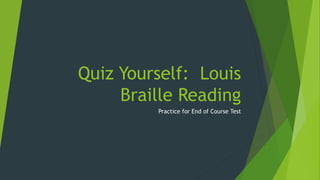Braille reading comprehension questions
- 1. Quiz Yourself: Louis Braille Reading Practice for End of Course Test
- 2. Louis Braille was the first person to invent an embossed system for the blind. a. true b. false TRUE He completed the writing system in 1824 when he was 15 years old!
- 3. Circle the word most closely related to tactile. a. cheap b. raised c. touch d. sensory C Tactile means able to be touched. If you are a tactile learner, you learn through using your hands (building, working with materials, etc.).
- 4. What is the word most closely related to embossed? a. felt b. dense c. touched d. raised D The Braille system is based on embossed or raised dots.
- 5. LouisŌĆÖ father was a famous musician who played cello and organ. a. true b. false FALSE Braille himself had a gift for music. His parents did not.
- 6. LouisŌĆÖ father and the village priest worked very hard to raise enough money to send Louis to the special school. a. true b. false FALSE They recognized his talent, but he ended up earning a scholarship.
- 7. Louis attended a special school in______________ a. Paris b. Marseille c. London d. Coupvray A. The school was located in Paris, France.
- 8. Louis invented the braille method: a. before his sixteenth birthday b. in a three-week period c. hoping to make a lot of money d. to make life better for other deaf children A He finished the method of writing at 15. Although it did make life better for others, it began as a method of communication for himself.
- 9. Before his death, Louis Braille enjoyed worldwide fame for his invention. a. true b. false B During his lifetime, the braille method was banned from schools. It was not accepted and celebrated until after his death.
- 10. He is buried at a. P├©re la Chaise Cemetary b. Arlington National Cemetary c. Versailles d. the Pantheon in Paris D His remains were moved to the Pantheon 100 years after he died.
- 11. How did you do? Send me a message! ’üŖ











